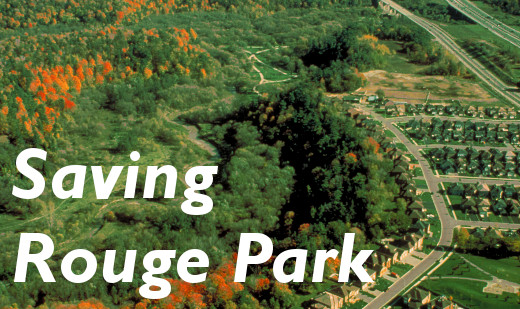
Are you a friend of the Rouge? These days it’s hard not to be, if you know about this amazing ecosystem teeming with rare and endangered wildlife, right in the Greater Toronto Area. Our guests talk about the road blocks they faced in saving the Rouge Valley system.
Rouge Park (The Rouge) is a magnificent semi-wilderness area nestled within Canada’s most populous region. It covers more than 45 square kilometres and has two National Historic Sites, including a significant First Nation village site and an old portage route.
The Rouge is so ecologically important that it’s on the way to becoming Canada’s first Urban National Park — a national park that will be accessible by public transit.
Saving the Rouge ecosystem has been a long journey, driven by the hard work of many environmental and community groups such as Save the Rouge Valley System (SRVS), which mobilized people to support the creation of Rouge Park; and Friends of the Rouge Watershed, which developed programs and activities so people can enjoy, learn about, and help restore the ecological health of the Park and watershed.
Today, Friends of the Rouge Watershed still works to protect and restore the beautiful Rouge Park. Each year, more than 10,000 school children visit the Rouge, studying its ecosystems, and perhaps most importantly, enjoying nature just minutes away from downtown and suburban neighbourhoods.
Early Days
The struggle to save the Rouge began in the 1970s, when Toronto was expanding with never-ending development. During that time, Torontonians noticed that there was still beautiful wilderness tucked into the city’s northeast corner. In 1975, local citizens formed SRVS to advocate for better planning and protection for the Rouge River and the valley system.
In 1967, a rich wetland northeast of Meadowvale Road and Hwy 401 was set aside for Canada’s Centennial. Even with this commemorative event, developers came and simply drained the wetland. To make matters worse, between 1965 and 1983, there was an active landfill near the Rouge Valley, east of the Toronto Zoo site. Anyone who lived there at that time will remember lots of garbage trucks, seagulls, dust, odours and rats.
The growing threats of urban sprawl spurred the SRVS. Developer after developer seemed to come and gobble up wetlands and forests. More needed to be done.
Building Local Political Support
In 1987, Joyce Trimmer, a Scarborough city councillor (later mayor of that city before it was amalgamated with Toronto), attended a SRVS meeting. Trimmer gave tough but crucial feedback helping focus the group and its goals.
The group’s first political experience was not encouraging. In the mid-1980s, they built public awareness of plans to develop 5,000 acres of land around the Rouge River Valley. But when Scarborough City Council voted, only Trimmer and one other councillor, Edith Montgomery, supported protecting Scarborough Rouge lands.
SRVS didn’t give up. Instead, they doubled their efforts to build a broad coalition of community, environmental and political groups, with public support. More than 1,000 people turned up for two Scarborough Council meetings. In 1988, Council voted to protect the 5,000 acres surrounding the Rouge Valley in northeast Toronto.
SRVS volunteers knew that the river, which supports the health of the valley and watershed, was still imperiled. There were plans for an adjacent highway and a bigger landfill and developments. SRVS had an idea, an alternative to endless development — the creation of a protected Rouge Park.
Another successful fight was the People or Planes campaign. In the 1970s, the provincial and federal governments purchased more than 30,000 acres by the Rouge River. The plan was to create a greenbelt surrounding a proposed international airport in North Pickering. In the end, the airport was not built, leaving most of these lands in public hands and potentially available for a Rouge Park.
Meanwhile on the Federal and Provincial scene
The Progressive Conservative (PC) government under then-Prime Minister Brian Mulroney, green for its time, was open to dialogue with activists. SRVS met with Pauline Browes, a PC Member of Parliament from Scarborough Centre, and the Waterfront Commissioner, David Crombie. Together, they gained support for the Rouge Valley from the federal government and then-Environment Minister Tom McMillan.
The Save the Rouge campaign was political but non-partisan. In addition to Browes and the PCs, the Ontario Liberal government, under then-Premier David Peterson and Environment Minister Jim Bradley, also supported protecting the Rouge. Bradley’s key aides Gary Gallon, Mark Rudolph, Sarah Rang and David Oved made sure the issue had the government’s attention.
In March 1990, Premier Peterson announced the province's plans to create a 10,500-acre (4,250-hectare) Rouge Park, from Lake Ontario to the Oak Ridges Moraine — almost exactly what SRVS asked for. PC Premier Mike Harris’ government added land to the park in 2001, and in 2005 Premier Dalton McGuinty’s Liberal government created the Greenbelt, which placed Rouge Park as "main ecological link" between Lake Ontario and the Oak Ridges Moraine.
Bob Hunter, the crusading environment reporter and a founder of Greenpeace, had encouraged SRVS volunteers to never give up, but he also told them to have a healthy dose of cynicism about government announcements. “If you’re not cynical, you’re not paying attention,” he said. His point: the battle for environmental protection does not end, it requires eternal activism.
In memory of Bob Hunter, Premier McGuinty created Bob Hunter Memorial Park in 2006.